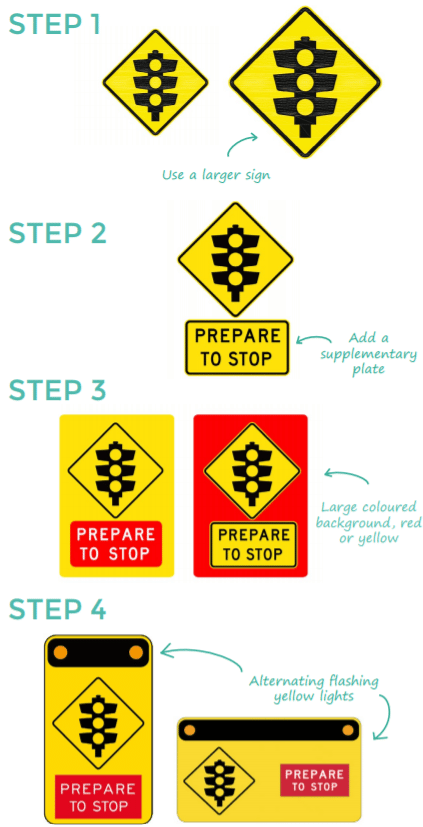Escalation of Warning Signs
Warning Signs are designed to warn road users of an upcoming hazard requiring caution. They are diamond shaped, with a black graphic illustrating the hazard on a yellow background, and can warn of a range of upcoming hazards such as blind crest, dip, steep descent, T-intersection, traffic lights, tight curve, narrow bridge, road hump, pedestrian crossing, or series of bends. In the case where the warning sign is not effective in adequately notifying the road user of the upcoming hazard, the following steps can be taken to better attract the attention of the road user.
4 Steps to escalation of Warning Signs
STEP 1
Use a larger size sign or duplicate the sign on both sides
of the road. There are four sizes (A to D) to choose from:
STEP 2
Add a supplementary plate underneath the sign
STEP 3
Put the sign assembly on a large coloured background,
yellow or red are preferred. Some States also use a
white or green background.
STEP 4
Install flashing yellow lights above the sign assembly
References:
Australian Standard AS 1742 Part 2 Traffic control devices for general useAustroads
Guide to Traffic Management Part 10 Transport Control – Types of Device


Your local contact:
Thuan Nguyen
Thuan is the Traffic Lead at Safe System Solutions Pty Ltd and an accredited Senior Road Safety Auditor. He is currently Chair of the Australian Standards MS012 committee Road Signs and Traffic Signals, and Transport lecturer at Swinburne University. Thuan has 20 years’ experience in Road Safety, Traffic Engineering and Road Management at local, State and national levels. If you have any question relating to Traffic Engineering, Road Management, Temporary Traffic Management, Road Safety, Road Rules, Regulations or policies, get in touch with Thuan.
e | Thuan.Nguyen@SafeSystemSolutions.com.au
m | 0431 757 757

